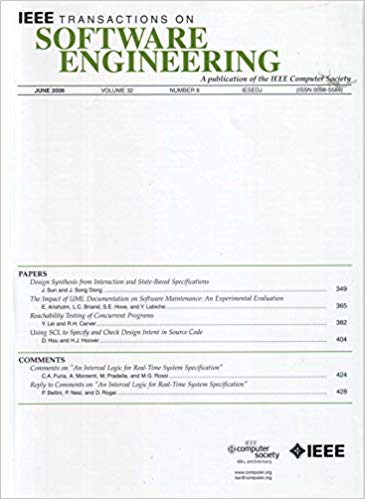识别遗留面向对象系统中的可重用服务:一种类型敏感的识别方法
IF 5.6
1区 计算机科学
Q1 COMPUTER SCIENCE, SOFTWARE ENGINEERING
引用次数: 0
摘要
将遗留软件系统迁移到面向服务的体系结构(SOA)是使此类系统现代化的主要策略之一。将遗留系统现代化为SOA的成功在很大程度上取决于所使用的服务标识方法,其目标是标识可能成为服务的可重用功能。在本文中,我们对学术界和工业界提出的服务识别方法进行了比较分析。我们表明,学术界和工业界在从遗留系统中识别服务的使用方法上存在差距。我们从比较分析中提取了一些关于服务标识方法应该具有的输入、过程和输出的建议。基于这些建议,我们提出了ServiceMiner,这是一种自下而上的服务标识方法,它依赖于源代码分析,因为其他信息源可能不可用或与实际代码不同步。ServiceMiner依赖于服务类型的分类和描述服务类型的代码级模式。我们通过四个案例研究来评估ServiceMiner。我们还将我们的结果与三种最先进的方法进行比较。我们表明,ServiceMiner识别架构重要服务的平均精度为78%,召回率为76%,F-measure为77%。本文章由计算机程序翻译,如有差异,请以英文原文为准。
Identifying Reusable Services in Legacy Object-Oriented Systems: A Type-Sensitive Identification Approach
The migration of legacy software systems to a service-oriented architecture (SOA) is one of the main strategies for modernising such systems. The success of modernising a legacy system to a SOA highly depends on the used service identification approach where the goal is to identify reusable functionalities that could become services. In this paper, we perform a comparative analysis of service identification approaches proposed by academia and industry. We show that there is a gap between academia and industry in the used approaches to identify services from legacy systems. We extract from the comparative analysis several recommendations about the inputs, processes, and outputs that a service identification approach should have. Based on these recommendations, we propose ServiceMiner, a bottom-up service identification approach, which relies on source-code analysis, because other sources of information may be unavailable or out of sync with the actual code. ServiceMiner relies on a categorisation of service types and code-level patterns characterising types of services. We evaluate ServiceMiner on four case studies. We also compare our results to those of three state-of-the-art approaches. We show that ServiceMiner identifies architecturally-significant services with, on average, 78% precision, 76% recall, and 77% F-measure.
求助全文
通过发布文献求助,成功后即可免费获取论文全文。
去求助
来源期刊

IEEE Transactions on Software Engineering
工程技术-工程:电子与电气
CiteScore
9.70
自引率
10.80%
发文量
724
审稿时长
6 months
期刊介绍:
IEEE Transactions on Software Engineering seeks contributions comprising well-defined theoretical results and empirical studies with potential impacts on software construction, analysis, or management. The scope of this Transactions extends from fundamental mechanisms to the development of principles and their application in specific environments. Specific topic areas include:
a) Development and maintenance methods and models: Techniques and principles for specifying, designing, and implementing software systems, encompassing notations and process models.
b) Assessment methods: Software tests, validation, reliability models, test and diagnosis procedures, software redundancy, design for error control, and measurements and evaluation of process and product aspects.
c) Software project management: Productivity factors, cost models, schedule and organizational issues, and standards.
d) Tools and environments: Specific tools, integrated tool environments, associated architectures, databases, and parallel and distributed processing issues.
e) System issues: Hardware-software trade-offs.
f) State-of-the-art surveys: Syntheses and comprehensive reviews of the historical development within specific areas of interest.
 求助内容:
求助内容: 应助结果提醒方式:
应助结果提醒方式:


